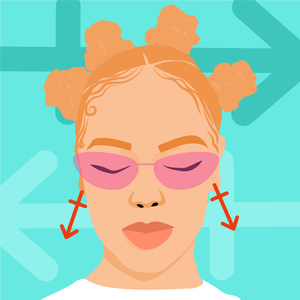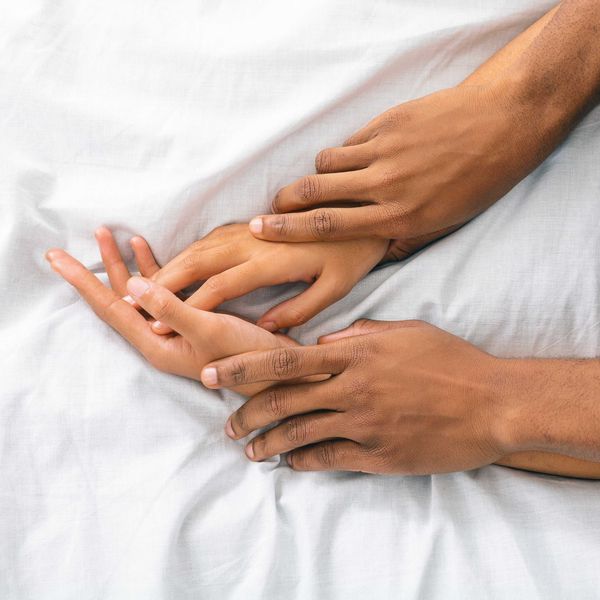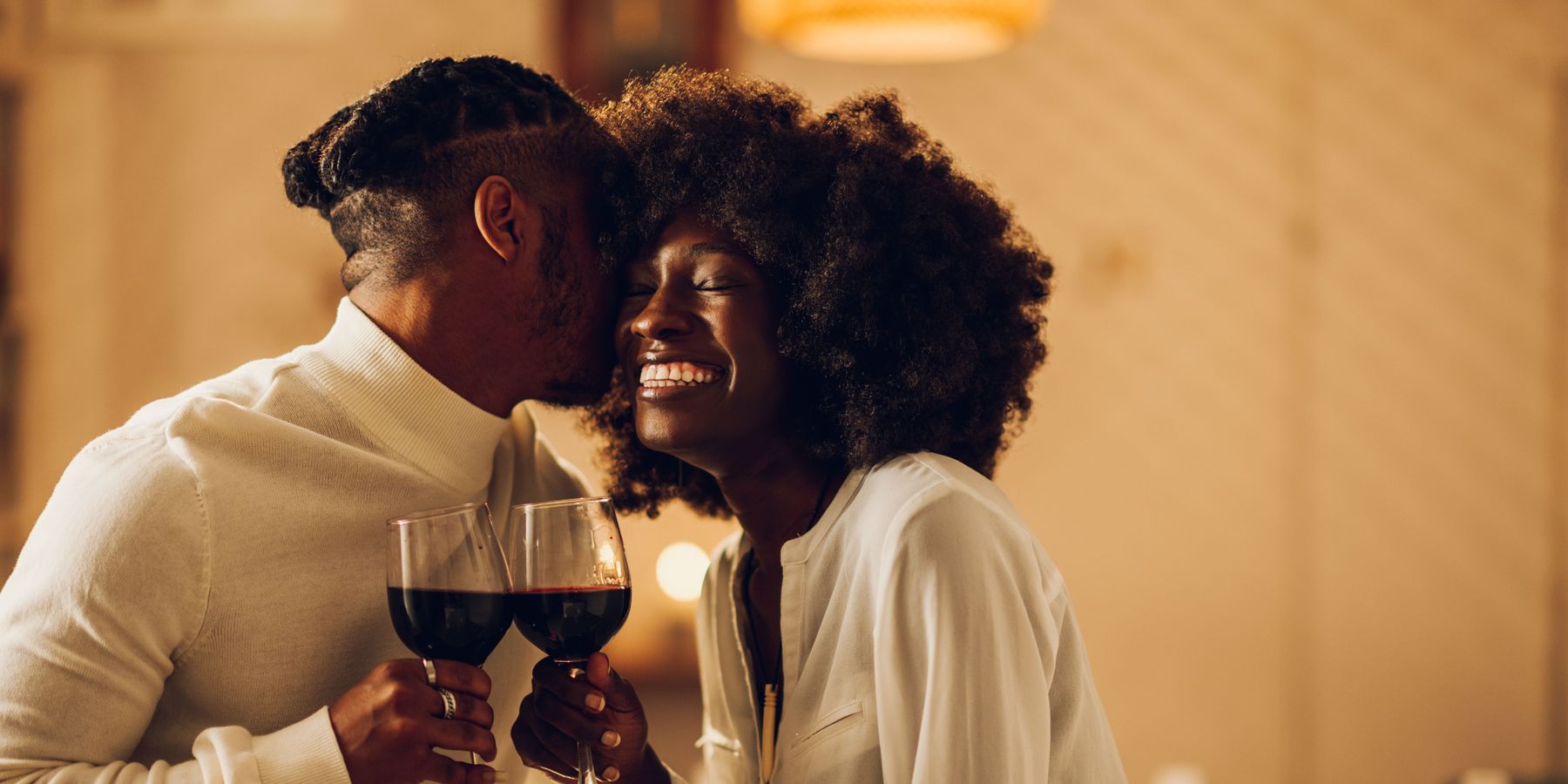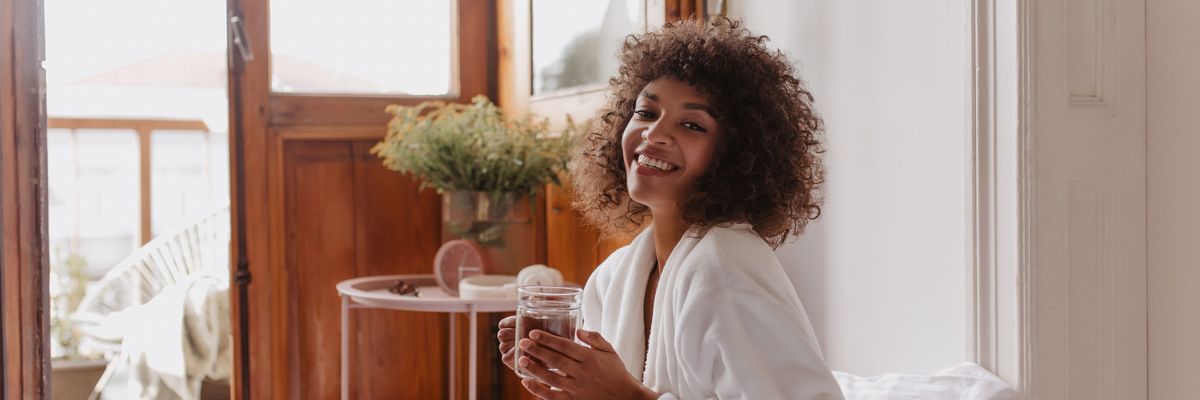
I'm pretty sure you're well aware of the fact that October is National Breast Cancer Awareness Month. This month definitely reminds us all about how necessary it is to perform breast self-exams. Also, if you're 45 or over, hopefully you've scheduled a mammogram (if you haven't had one already this year). Remember, although we are diagnosed with this particular form of cancer at a slightly lower rate than white women, the reality is our mortality is noticeably higher.
As I was reflecting on the fact that I am now in the age bracket where annual mammograms are important (gee, where does the time go?), it got me to thinking about something else that is important for all of us to do. Something that doesn't seem to come up nearly as often, but can be just as life-saving—vaginal self-exams. I try to give myself one about every 3-4 weeks or so. When's the last time you did it?
If the answer is "never", here are the reasons why you should, along with how to go about making it a routine part of your proactive self-care routine.
Why You Should Be Looking Down There More Than You (Already) Do
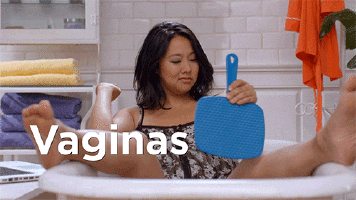
I'm not sure if it's a generational thing or what, but I find it to be interesting that whenever I ask the women in my life who are over 50 if they look at their vagina, they act like I'm speaking German; meanwhile, if I ask a woman in her 20s if she does, I darn near have to keep her from spreadin' it wide right in front of me. I have pried a little when it comes to a few older women by asking them what the big deal is with looking at their va-jay-jay. Usually they say something along the lines of, "I barely wanted to see my own baby being born" or (if they are down with receiving oral sex; some aren't), "I'll just let my man tell me if something is up. He's there more than I am anyway."
Me? I'm kind of a natural picker. I had to train myself to leave pimples alone. Every time a new age freckle pops up (a "gift" from my maternal grandfather), I almost immediately notice. And yes, I am neither hesitant nor ashamed to say that whenever I am doing my own up-close-and-very personal lady-scaping, I usually get a mirror to check out what's going on down below. It's not so much that I'm worried that something is wrong; it's just that I find my vagina to be really fascinating. Dope, even.
Now if you're someone who is like, "I may not be in my 50s but I don't have a desire to look at my hoo-haw either" and your main rationale is because "that's what pap smears are for", here's something to think about. Although there used to be a time when pap and pelvic exams (mostly to check for cervical cancer cells) were recommended on an annual basis, most health professionals now agree that if you are between the ages of 21-65, every three years is fine. For those of us who kinda sorta hate pap smears, that's good news. But OK, what about all of those months in between your visits to the doctor; especially if you are sexually active?
This is where a vaginal self-exam comes into play.
While there is nothing quite like the technology of medical equipment and the knowledge of a medical professional, performing a vaginal self-exam can help you to see if there is a noticeable change in your discharge, if there are growths (including bumps, sores or "weird-looking spots") or drastic changes in color when it comes to your clitoris or your labia majora (inner lips) or labia minora (outer lips).
If there's a part of you that is still giving push back by saying, "OK, but if there were issues like that, wouldn't I feel it?" Eh, maybe. Maybe not. But since some STDs including chlamydia and HPV are typically asymptomatic, and even bacterial vaginosis is asymptomatic in nearly half of all women, it can never hurt to 1) get used to what your vagina—well, technically your vulva; your vagina is the inside part while your vulva is the outside part—looks like when it's healthy so that 2) you are able to detect fairly early on if something appears abnormal in anyway. After all, when it comes to your overall health and well-being, early detection of anything always works in your favor.
How Do You Perform a Vaginal Self-Exam?

I really am hoping that I've compelled you to at least consider giving yourself a vaginal self-exam. Trust me, it's not that hard to do.
What you'll need is a:
- Handheld mirror
- Pillow
- Small flashlight
- Gloves for your hands (like the ones you would use to perm your hair with)
- Diagram of the vulva (you can look one up online or download this one here)
- Journal or smartphone
- Wash your hands thoroughly and/or apply a pair of sterile gloves.
- Remove all of your clothing from the waist down (some people like to do this after the shower, but you can't always detect your discharge that way; right when you wake up is probably your best bet).
- Whether it's on your bed or the floor, put a towel underneath you and then prop your butt up with a pillow.
- Pull your feet back towards your butt as far as they will comfortably go and spread your legs wide.
- Relax your pelvic muscle. Then, with your mirror, start inspecting, beginning with your mons pubis (the top of your vulva where most of your pubic hair is), then your clitoris, then your lips (outside and inside) and then the opening of your vagina and anus. Look to see if there are any noticeable changes that you haven't seen before (or if it's your first time, take note if anything alarms you). If there is, jot it down in your journal or smartphone (by the way, smartphones are pretty gross, germ-wise. You might want to clean it before conducting your self-exam; just to be on the safe side). Don't be afraid to gently pull back the folds of your vulva, to peek into your clitoris' hood or to even stick a finger into your vagina to make sure that your walls are a pinkish color and the texture is smooth.
- Once you are done, if something seems different to the point of slightly alarming, write it down and make an appointment to see your doctor. Again, the sooner you notice something "strange" and your physician is made aware, the sooner your vulva and vagina can get to feeling like their normal self (plus, it can prevent you from infecting someone else, even if you've got something as simple as a yeast infection). After getting the hang of this, it should take no more than 15 minutes tops.
After you've completed your vaginal self-exam, treat you and your vagina to a homemade strawberry and avocado smoothie (it'll help to keep your vagina's pH in check) or a nice pair of organic cotton undies (since you need to swap those out every six months anyway). You've taken super responsible measures to keep "her" happy. You've certainly earned it!
Want more stories like this? Sign up for our newsletter here and check out the related reads below:
15 Things I Bet You Didn't Know About Your Own Vagina
10 Things Your Vagina Wishes You Would Do More Often
These Common Habits Are Actually BAD For Your Vagina
Keep Your Vagina Like A (Literal) Fountain Of Youth
Feature image by Shutterstock
- Pap Smears Preventative Cervical Health - xoNecole: Women's Interest, Love, Wellness, Beauty ›
- Do Vaginas Get Loose? Myth Debunk - xoNecole ›
- Self Care - It's OK to Peek! How to perform self cervical and vaginal ... ›
- Vaginal Self-Examination (VSE) ›
- Vulvar Self-Exam | Gynecology | Dartmouth-Hitchcock ›
- How to Perform a Vaginal Self-Exam ›
- What Does the Inside of a Vagina Look Like? Telling If You're Healthy ›
- What should you look for in a vaginal self-exam? ›
- Vaginal Self-Examination (VSE) | Kaiser Permanente ›
- Vaginal Self-Exam: What Does A Normal, Healthy Vagina Look Like? ›
This Is How To Keep 'Holiday Season Stress' From Infecting Your Relationship
Hmph. Maybe it’s just me, but it seems like there is something really weird happening in the fall season air (because winter doesn’t officially begin until December 21) that cuddle season is in full swing while break-up season is as well. In fact, did you know that break-ups are so popular during the holiday season that December 11 is deemed Break-Up Day?
The reasons why relationships shift around this time vary; however, I did both roll my eyes and chuckle when I read that a very popular one is because it’s an easy way to get out of getting one’s significant other a Christmas present. SMDH.
Anyway, I personally think that the less shallow folks out here may contemplate calling things “quits” or they at least distance themselves a bit from their partner (and what I’m referring to is serious relationships) due to all of the stress and strain that oftentimes comes with the holidays whether it be financial, familial, due to their tight schedules or something else.
Listen, I would hate for you and your man to miss the fun and happiness of experiencing this time of year, all because you are so overwhelmed or irritated that you can’t really enjoy it. That’s why I have a few practical tips for how to avoid allowing the typical holiday season stress from INFECTING your relationship.
Manage Your Expectations
 Giphy
GiphyUnmanaged expectations. If there is a main reason why the holiday season tends to be so stress-filled for so many people, I’d bet good money that this is the cause. And when you’re in a long-term relationship, expectations can manifest themselves in all sorts of cryptic and/or unexpected ways. You might have relatives who assume that you are going to be with them for Thanksgiving or Christmas when you have other plans in mind. You might be thinking that you are going to spend one amount for presents while your man is thinking something totally different. When it comes to scheduling, your signals may be crossed.
And you know what? To all of these scenarios, this is where clear and consistent communication come in. Don’t assume anything. Don’t dictate anything either. From now until New Year’s, mutually decide to check in once a week, just to make sure that you are both on the same page as it relates to the holidays and what you both are thinking will come along with it. The less blindsided you both feel, the less stressed out you will be. Trust me on this.
Set (and Keep) a Budget
 Giphy
GiphyOkay, so I read that last year, 36 percent of Americans incurred some type of holiday-related debt. Hmph. Last year, there was still some sense of normalcy in this country, chile, so I can only imagine what finances are gonna look like over the next several weeks. That said, since I don’t know a lot of people who don’t find being broke stressful, make sure that you and your bae set a budget and then stick to it this year — no ifs, ands or buts.
Because really, y’all — it doesn’t make sense to deplete savings and/or max out credit cards for a few days of giggles only to be damn near losing your mind because you don’t know how to make ends meet come Dr. Martin Luther King, Jr. Day.
And by the way, this tip doesn’t just speak to things like food and gifts; I also mean travel. If it doesn’t make a ton of sense (or cents) to be all over the place this year — DON’T BE.
Keep Matthew 5:37 at the Forefront
 Giphy
GiphyIf off the top of your head, you don’t know what Matthew 5:37 says, no worries, here ya go: “But let your ‘Yes’ be ‘Yes,’ and your ‘No,’ ‘No.’ For whatever is more than these is from the evil one.” That verse right there? Oh, it’s a boundaries lifesaver! I say that because do you see “maybe” or “I’ll think about it” in there? Nope. LOL. It says that you should tell people “yes” or “no” and leave it at that — and that complements Anne Lamott’s quote, “’No’ is a complete sentence” impeccably well. Yeah, you’ve got to remember that anything beyond a yes or no to a request is privileged information; you don’t owe anyone details or an explanation.
Besides, if you are really honest with yourself, when someone asks you something and you give a “Umm, let me think about it” kind of reply, more times than not, you already know what your answer is going to be — so why not let you both off of the hook? Give your response. Commit to that. And let everyone (including yourself) get on with their lives and schedules.
I promise you that when it comes to those holiday parties, you are pissing more folks off by not RSVP’ing or doing so and not showing up than just saying, “Thank you but not this year” off the rip.
Remember That Your Personal Space Is Privilege Not a Right
 Giphy
GiphyA friend of mine recently bought a new house and invited me over to come see it. He’s a single man with no children, so as I was taking in all of the space that he had, especially as I walked through his finished basement, I joked about relatives coming to live with him. “Hell no” and “absolutely not” were pretty much his immediate responses as he went on to say that some folks even had the nerve to be offended when he told them that he had no intentions on taking DNA in.
Ain’t it wild how people think that your stuff is their right? And yes, that brings me to my next point. Your home is your sanctuary space. If you want to host folks this year — cool. If not, ALSO COOL. Please don’t let folks (family included) guilt you into how they want you to act or even into what they would do if the shoe was on the other foot. You are not them — and as one of my favorite quotes states, “If two people were exactly alike, one of them would be unnecessary.” (A man by the name Larry Dixon said that.)
Hell, my friends? They know that I am good for sending them random things that they need or even want all throughout the year. Coming over to hang out at my pace, though. Uh-uh. Chalk it up to being a card-carrying member of the ambivert club yet I like keeping my living space personal — and I sleep like a baby, each and every night, for feeling that way.
Always remember that your space, your time, your resources, your energy and shoot, yourself period (including your relationship), are all things that are your own. You get to choose how, when and why you want to share them. The holiday season is certainly no exception.
Cultivate Some “You Two Only” Traditions
 Giphy
GiphyIt’s not uncommon for some couples to hit me up after the holiday season to “detox.” Sometimes it’s due to the financial drama (and sometimes trauma) that they experienced. Sometimes it’s because they allowed their relatives (especially in-laws) to get more into their personal business than they should’ve. More than anything, though, it tends to be because they didn’t get enough quality time together and so ended up feeling “disconnected.”
Please don’t let that happen. Listen, I’m not even a holidays kind of woman and yet, I will absolutely sit myself down with some hot chocolate and chocolate chip cookies to enjoy a Hallmark holiday film or two. Aside from the fact that most of them are lighthearted and sweet, I also like that they usually focus on couples loving on each other amidst all of the holiday beauty and ambiance — which is something that all couples should set aside some time to do.
Maybe it’s a vacation. Maybe it’s a staycation. Or maybe it’s my personal favorite, A SEXCATION. Whether it’s for a few days, the weekend or even overnight — don’t you let the holidays go by without setting aside time for you and your man to celebrate one another. Don’t you dare (check out “Are You Ready To Have Some Very Merry 'Christmas Sex'?”).
GET. SOME. REST.
 Giphy
GiphyI once read that 8 out of 10 people get stressed out over the holidays and 3 out of 10 lose sleep during to it — and when you’re stress-filled and sleep-deprived, that can absolutely lead to hypersensitivity, making mountains out of molehills and even not being in the mood for sex.
Your relationship can’t afford to go through any of this, so definitely make sure to prioritize rest. I don’t care how unrealistic it might seem during this time, sleep should never be seen as a luxury; it will always and forever be a great necessity.
That said, try to get no less than six hours of shut-eye in (check out “6 Fascinating Ways Sex And Sleep Definitely Go Hand In Hand”) and even ask your bae to take a nap with you sometimes (check out “Wanna Have Some Next-Level Sex? Take A Nap, Sis.”). Not only will sleep help to restore your mind, body and spirit but, when it’s with your partner, it’s an act of intimacy that can make you both feel super connected, even in the midst of what might feel like chaos.
___
Holiday season stress is real. Still, never give it the permission or power to throw your relationship off. Put you and your man first and let the holidays be what they are gonna be, chile.
Let’s make things inbox official! Sign up for the xoNecole newsletter for love, wellness, career, and exclusive content delivered straight to your inbox.
Featured image by Shutterstock
Whew. Did you know that somewhere around 122 million Americans travel during the holiday season? Listen, I went to see my godbabies this past September and got caught up in a crazy ass traffic jam at BNA (the Nashville airport) that damn near has me considering air travel ever again — especially during this time of the year.
Besides, it’s not like it’s a written rule that you have to travel over the holidays. In fact, if you want to play it chill this year, why not enjoy a staycation instead? Although it might seem like it’s a “poor man’s compromise,” as you’re about to see, it actually…isn’t.
1. Go All Out with the Christmas Décor
 Giphy
GiphyThere is someone I know who is so obsessed with Christmas, she’s damn near annoying-borderline-terrifying. I’m. Not. Kidding. Yet hey, if you’re going to do a holiday-themed staycation (emphasis on “holiday-themed”), that’s kind of how you’ve got to be. Some décor ideas include:
- A fresh Christmas tree (is the most ideal) that is ultimately decorated
- Wreaths on outside and inside doors
- Garland (with twinkle lights) in predictable and unpredictable places
- Poinsettias
- Mistletoes
- Snow globes
- A stocking (with some of your favorite things in it)
- Fake snow
- Stars
- Angels
- Candy canes
- A BLACK Santa (LOL)
I mean, since you are going to be spending a lot of time at home, it can feel like a mini-winter wonderland if you are intentional about doing more decorating to your living space than you ever have before!
2. Buy a Couple of Christmas-Themed PJs
 Giphy
GiphyWhile I was doing some research on a totally different topic, I happened upon an article that talked about the psychology behind why we should be intentional about what we wear to bed. When you stop to think about the fact that (hopefully) you are sleeping somewhere between 6-8 hours every night, it would make sense that things like the color and fabric of your sleepwear would have a real impact on you — even subconsciously.
Well, when it comes to Christmas décor, specifically, not only does it take you back to nostalgic memories, it can also boost your moods. So, aside from being on-10 with your Christmas décor, also invest in some Christmas-themed PJs. Since you’re going to be doing a lot of lounging around (RIGHT?), do it in something that makes you think about all of your favorite things about this time of year.
3. Cop Some Christmas-Scented Candles
 Giphy
GiphyThere really is no telling how many articles that I’ve written where I am singing the praises of scented soy candles. Candles are soothing, comforting and a very easy way to reduce stress. Also, since it gets darker quicker and for a longer period of time around this time of the year, candles provide a relaxing vibe to your home. Since it is Christmastime, go with scents that are reminiscent of the season:
- Cinnamon
- Vanilla
- Cranberry
- Apple
- Pine
- Frankincense and Myrrh
- Peppermint
- Cashmere
- Ginger(bread)
- Orange
- Sugar Cookies
- Sandalwood
- Cloves
- Cedarwood
- (Hot) Chocolate
Personally, one of my favorite candle companies is Goose Creek. Their signature collections will have your entire house smelling like a high-end bakery. No exaggeration.
4. Play Some Winter-Themed ASMR Sounds
 Giphy
GiphyI’m from Nebraska and my mother was a New Yorker. So, if there is one thing that I like, it’s seasons and that includes snow during wintertime. Unfortunately, Nashville is cray-cray when it comes to that. If, where you live, the weather is all over the place too (which is why I think it’s insane that some people still give pushback to global warming) and you would like for it to at least seem like you are in your own winter wonderland — invest in some fake snow to strategically place around your home.
Oh, and don’t forget to turn on some winter-themed ASMR sounds too. YouTube has videos that run for hours on end that feature blizzards and howling winds that really can make you feel like you are in the midst of an ice storm.
5. Host a Holiday Movie Marathon
 Giphy
GiphyOne thing to remember about a staycation is it doesn’t mean that you have to be alone or that the only people who can participate are the ones who live with you. Since a staycation is simply about staying close to home instead of traveling afar — absolutely consider having some of your favorite people over for a holiday-themed movie marathon. Shoot, Black America Web even did you a solid by publishing “25 Best Black Christmas Movies Of All Time;” plus, Tubi has a Black holiday hits section of indie films too.
Oh, and make sure to get creative with the Christmas-themed snacks. Some ideas? Some Kentucky-fried turkey tenders with cranberry hot sauce (recipe here), some Holiday Hot Spinach Dip (recipe here), some Grinch Kabobs (recipe here), some roasted pecans (recipe here) and some Pomegranate Guacamole (recipe here).
6. Spend a Night (or Two) at a Hotel or Vacation House
 Giphy
GiphyJust like you don’t have to be alone during a staycation, you also don’t have to be cooped up in your house the entire time. Get a change of scenery in your own city by spending the night in a hotel that you’ve always wanted to try out or renting a vacation house for you and some of your folks to hang out in during the time between Christmas and New Year’s Day. I have a “love little sister” who does this randomly when she needs a break from her work as a therapist. She says that it’s damn near like taking a trip (and she has PLENTY of passport stamps; trust me).
7. Have Brunch or Dinner at a Christmas-Themed Restaurant
 Giphy
GiphyIf nothing puts a bigger smile on your face than the thought of DoorDashing meals and barely even touching your stove during your staycation — hey, I am right there with you. Do consider going out to brunch or dinner during your chill time, though. It’s another way to bond with people and create some current holiday memories. And if you’ve got a bae and you opt for dinner, it can be a wonderful type of Christmas-themed date.
8. Go to a Holiday-Themed Concert
 Giphy
GiphyBeing that I got my start as an entertainment writer, hear me when I say that I’m not someone who just has to go to a live concert every chance that I get. Oh, but baby, when I saw that El DeBarge was doing a City Winery tour and he was going to be here right before Christmas — I booked myself a ticket quick, fast and in a super-duper hurry! Shoot, I didn’t even want to go with someone because I plan to give him and that falsetto voice of his my complete and undivided attention. LOL.
I don’t know what it is about the holiday season that makes live music that much more enjoyable — but if there is a concert that features one of your favorite artists happening right through here, consider that to be a cool way to “tour your city” while cultivating a really awesome memory at the same time.
9. Also, Go Ice Skating
 Giphy
GiphyOne of my fondest memories of time with my father is going ice skating. We actually would do it in the summer (because that is when I would visit him) and, every year, he would get me a new ice skating outfit. Even now, when I watch someone ice skate (even in movies; like in the classic movie Garden State), I will have warm fuzzies.
Anyway, if you’ve never been before, go. If it’s been forever since you have, also go. There is something that is very sweet and so signature Christmas about it. Plus, it’s a top-tier form of exercise.
10. Take a Christmas Lights Tour
 Giphy
GiphyAnother one of my favorite Christmas memories is driving through neighborhoods and looking at the Christmas lights. And just like a Christmas concert can be a form of hometown touring, so can doing this if you decide to choose a couple of areas where you’ve never really been or rarely frequent.
Now are you excited about the thought of experiencing a holiday-themed staycation?
I thought you would be. ENJOY!
Featured image by Shutterstock

